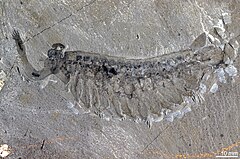| Opabinia Temporal range: Middle Cambrian (Wuliuan),
| |
|---|---|

| |
| Fossil specimen (holotype) on display at the Smithsonian in Washington, D.C. | |
| Scientific classification | |
| Domain: | Eukaryota |
| Kingdom: | Animalia |
| Phylum: | Arthropoda |
| Family: | †Opabiniidae |
| Genus: | †Opabinia Walcott, 1912 |
| Species: | †O. regalis
|
| Binomial name | |
| †Opabinia regalis Walcott, 1912
| |
Opabinia regalis is an extinct, stem group arthropod found in the Middle Cambrian Burgess Shale Lagerstätte (505 million years ago) of British Columbia.[1] Opabinia was a soft-bodied animal, measuring up to 7 cm in body length, and its segmented trunk had flaps along the sides and a fan-shaped tail. The head shows unusual features: five eyes, a mouth under the head and facing backwards, and a clawed proboscis that probably passed food to the mouth. Opabinia probably lived on the seafloor, using the proboscis to seek out small, soft food.[2] Fewer than twenty good specimens have been described; 3 specimens of Opabinia are known from the Greater Phyllopod bed, where they constitute less than 0.1% of the community.[3]
When the first thorough examination of Opabinia in 1975 revealed its unusual features, it was thought to be unrelated to any known phylum,[4] or perhaps a relative of arthropod and annelid ancestors.[2] However, later studies since late 1990s consistently support its affinity as a member of basal arthropods, alongside the closely related radiodonts (Anomalocaris and relatives) and gilled lobopodians (Kerygmachela and Pambdelurion).[5][6][7][8][1][9][10]
In the 1970s, there was an ongoing debate about whether multi-celled animals appeared suddenly during the Early Cambrian, in an event called the Cambrian explosion, or had arisen earlier but without leaving fossils. At first Opabinia was regarded as strong evidence for the "explosive" hypothesis.[4] Later the discovery of a whole series of similar lobopodian animals, some with closer resemblances to arthropods, and the development of the idea of stem groups, suggested that the Early Cambrian was a time of relatively fast evolution, but one that could be understood without assuming any unique evolutionary processes.[11]
- ^ a b Briggs, Derek E. G. (2015-04-19). "Extraordinary fossils reveal the nature of Cambrian life: a commentary on Whittington (1975) 'The enigmatic animal Opabinia regalis, Middle Cambrian, Burgess Shale, British Columbia'". Philosophical Transactions of the Royal Society B: Biological Sciences. 370 (1666): 20140313. doi:10.1098/rstb.2014.0313. PMC 4360120. PMID 25750235.
- ^ a b Whittington, H. B. (June 1975). "The enigmatic animal Opabinia regalis, Middle Cambrian Burgess Shale, British Columbia". Philosophical Transactions of the Royal Society B. 271 (910): 1–43 271. Bibcode:1975RSPTB.271....1W. doi:10.1098/rstb.1975.0033. JSTOR 2417412. Free abstract at Whittington, H. B. (1975). "The Enigmatic Animal Opabinia regalis, Middle Cambrian, Burgess Shale, British Columbia". Philosophical Transactions of the Royal Society B. 271 (910): 1–43. Bibcode:1975RSPTB.271....1W. doi:10.1098/rstb.1975.0033.
- ^ Caron, Jean-Bernard; Jackson, Donald A. (October 2006). "Taphonomy of the Greater Phyllopod Bed community, Burgess Shale". PALAIOS. 21 (5): 451–65. Bibcode:2006Palai..21..451C. doi:10.2110/palo.2003.P05-070R. JSTOR 20173022. S2CID 53646959.
- ^ a b Cite error: The named reference
:0was invoked but never defined (see the help page). - ^ Cite error: The named reference
Budd1996was invoked but never defined (see the help page). - ^ Budd, Graham E. (1998). "The morphology and phylogenetic significance of Kerygmachela kierkegaardi Budd (Buen Formation, Lower Cambrian, N Greenland)". Earth and Environmental Science Transactions of the Royal Society of Edinburgh. 89 (4): 249–290. doi:10.1017/S0263593300002418. ISSN 1473-7116. S2CID 85645934.
- ^ Cite error: The named reference
ZhangBriggs2007was invoked but never defined (see the help page). - ^ Cite error: The named reference
Budd2011was invoked but never defined (see the help page). - ^ Ortega-Hernández, Javier (2016). "Making sense of 'lower' and 'upper' stem-group Euarthropoda, with comments on the strict use of the name Arthropoda von Siebold, 1848". Biological Reviews. 91 (1): 255–273. doi:10.1111/brv.12168. PMID 25528950. S2CID 7751936.
- ^ Ortega-Hernández, Javier; Janssen, Ralf; Budd, Graham E. (2017-05-01). "Origin and evolution of the panarthropod head – A palaeobiological and developmental perspective". Arthropod Structure & Development. 46 (3): 354–379. doi:10.1016/j.asd.2016.10.011. ISSN 1467-8039. PMID 27989966.
- ^ Cite error: The named reference
Budd2003was invoked but never defined (see the help page).